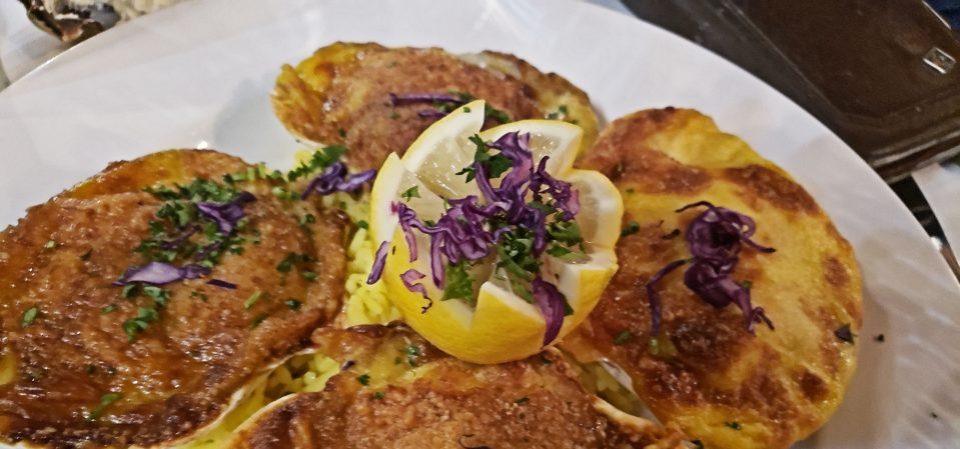Tags
 We had never eaten kohlrabi before. This was a real treat – Kohlrabi Schnitzel. And it was delicious! You can get the recipe for this and several variations at German Foods – Kohlrabi.
We had never eaten kohlrabi before. This was a real treat – Kohlrabi Schnitzel. And it was delicious! You can get the recipe for this and several variations at German Foods – Kohlrabi.
Etymology:
The name comes from the German Kohl (“cabbage”) plus Rübe ~ Rabi (Swiss German variant) (“turnip”), because the swollen stem resembles the latter, hence its Austrian name Kohlrübe. Kohlrabi is a very commonly eaten vegetable in German speaking countries.
In India, Kohlrabi is more commonly called Knolkhol (English) or Nookal (Hindi). It is also used extensively in the southern part of India. In Kannada, Kohlrabi is called Gedde Kosu or Navilu Kosu. In Kashmiri, the swollen stems are called Moonji (singular: Muund) and the leaves are called Haakh or munji Haakh. One commonly used variety grows without a swollen stem, having just leaves and a very thin stem, and is called Haakh.
Across the United States and Canada, Kohlrabi is seeing a resurgence stemming from the ever-increasing demand for locally grown produce; a trend that goes hand-in-hand with increased variety. Small farmers across North America are enjoying increased sales by cultivating a wider variety of what are now—especially after nationwide agricultural homogenizing efforts over the last half-century, especially in the United States—novel vegetables. Rapid spread of kohlrabi has resulted in a slew of regional name variations. West-coast renditions include bralicaki, bralicocci, and calibrabra. Caliabra, ralibraca, and braliacra are some regional variations heard in the north-eastern regions of the United States. Canadian variations include brawnitabra and tawnybrauble while southern United States have coined caulibrocky and brockycocky.
Description:
Kohlrabi has been created by artificial selection for lateral meristem growth (a swollen, nearly spherical shape); its origin in nature is the same as that of cabbage, broccoli, cauliflower, kale, collard greens, and Brussels sprouts: they are all bred from, and are the same species as the wild cabbage plant (Brassica oleracea).
The taste and texture of kohlrabi are similar to those of a broccoli stem or cabbage heart, but milder and sweeter, with a higher ratio of flesh to skin. The young stem in particular can be as crisp and juicy as an apple, although much less sweet.
A basket of kohlrabi:
Except for the Gigante cultivar, spring-grown kohlrabi much over 5 cm in size tend to be woody, as do full-grown kohlrabi much over perhaps 10 cm in size; the Gigante cultivar can achieve great size while remaining of good eating quality. The plant matures in 55–60 days after sowing. Approximate weight is 150 g and has good standing ability for up to 30 days after maturity.
There are several varieties commonly available, including White Vienna, Purple Vienna, Grand Duke, Gigante (also known as “Superschmelz”), Purple Danube, and White Danube. Coloration of the purple types is superficial: the edible parts are all pale yellow. [Wikipedia]
The dinner that we had, and pictured above was
Acme Bakeshop Rye Bread
Garlic Potatoes with Housemade Sauerkraut
Kohlrabi Schnitzel with Housemade Lime Mayonnaise
We thoroughly enjoyed this meal and will probably make the Kohlrabi again.

I wish there were some left-overs. It was really good!
LikeLike
Comin’ over:-) Hope there are left overs!
LikeLike